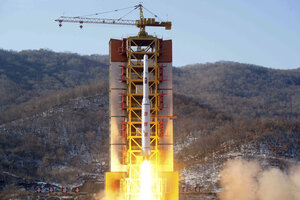What N. Korea's rocket test tells us about its military capability
Pyongyang is ramping up its nuclear and missile programs after a successful rocket launch Feb. 7. US officials warn that the North is trying to obtain weapons-grade fissionable material from a previously shuttered reactor.

This Feb. 7, 2016 image released by the Korean Central News Agency (KCNA) and distributed by the Korea News Service (KNS) shows a rocket lifting off, said to be carrying North Korea's Earth observation satellite Kwangmyongsong-4, at the Sohae launch pad in Tongchang-ri, North Korea.
Korean Central News Agency/Korea News Service via AP
Seoul, South Korea
North Korea’s weapons program is back in the spotlight after a long-range rocket launch on Feb. 7 that came just a month after a fourth nuclear test.
Pyongyang characterized the rocket as part of a peaceful space program involving the placement of a weather satellite. But the US, South Korea and Japan, among other countries, see the test as a pretext to develop intercontinental ballistic missiles (ICBM) capability.
The UN Security Council strongly condemned the launch, vowing to apply further sanctions against the already isolated country. While much remains unknown, analysts continue to scrutinize North Korea's nuclear and missile programs.
Here are four basic questions about these programs:
Did this missile test represent a technical breakthrough?
The answer scientists are suggesting so far is, no.
Experts say the rocket that launched the Kwangmyongsong-4 satellite into orbit was nearly identical to one fired in 2012, called the Unha-3.
“I don't see a lot of difference between the Kwangmyongsong carrier rocket and the Unha-3," says Melissa Hanham, senior research associate at the James Martin Center for Nonproliferation Studies in Monterey, Calif. "The high resolution images, similar splashdown zones, and recovered wreckage all point to little or no change,”
Ms. Hanham says that footage of the Feb. 7 rocket launch, released by North Korean state media on Wednesday, should yield further clues, such as acceleration.
The Unha-3 has an estimated range of 7,000 miles, theoretically bringing the US West Coast within range. The rocket was used to place a satellite in orbit (though whether the satellite is functional is unclear.)
Unlike in 2012, the first stage booster of the multi-stage rocket exploded after detaching, rather than simply falling back to earth. Based on debris recovered from the sea, South Korea’s Ministry of National Defense said the booster appeared to have self-destructed. That would indicate an effort by Pyongyang to thwart external analysis of its capabilities.
In addition, the rocket may have been more accurate, even if off target, writes aerospace engineer John Schilling on the Johns Hopkins University-affiliated website "38 North."
Is North Korea close to perfecting an ICBM?
A satellite launch missile is not simply an ICBM without a warhead. To strike its target, an ICBM must be able to reenter the atmosphere intact after reaching space. While Pyongyang has twice placed an object in the earth’s orbit using a multi-stage rocket, it has never demonstrated the ability to bring anything back in one piece.
“This is the last year of North Korea’s first five-year space development plan,” says Uk Yang, a senior research fellow at Korea Defense and Security Forum. “So the second five-year plan may include a bigger rocket with much bigger payload, and even reentry vehicle back into the atmosphere.”
An effective ICBM must also be more accurate than the rockets Pyongyang has tested so far. The Feb. 7 rocket would have been 30 miles short and six miles west of its intended target, according to Mr. Schilling’s analysis.
Finally, an effective weapon must be quickly deployable. The Feb. 7 rocket was ready faster than its 2012 predecessor. But satellite images showed that the latest test launch took days to prepare, showing it is not ready for military capability.
Putting an exact timeframe on when North Korea might have a functioning ICBM is impossible; the consensus is that it’s still some years away.
What is the state of play of Kim's nuclear program?
Last month, Pyongyang said it had detonated a hydrogen bomb. Governments and analysts poured doubt on the claim. They said seismic activity triggered by the device on Jan. 6 was too mild to signify such an advanced weapon and was more in line with North Korea’s three previous nuclear fission-based tests.
James Acton at the Carnegie Endowment for International Peace has said the device may have been a kind of hybrid, involving a conventional atomic device “boosted” with small amounts of hydrogen isotopes.
More recently, an anonymous US official briefed reporters in Washington to revise the earlier skeptical assessment. The official said the test had been carried out further underground than initially thought and could have involved “components” of a H-bomb, even if it was not a successful detonation.
Of North Korea's four nuclear tests since 2006, the first two are believed to have used plutonium from its Yongbyon nuclear facility. Where the fissionable material came from the last two tests is unclear. The complex was closed in 2007 as part of a denuclearization deal, but Pyongyang announced in September that Yongbyon was starting up again. US Director of Intelligence James Clapper confirmed this week that Pyongyang could be ready to begin recovering plutonium for a bomb within weeks and was expanding uranium enrichment.
In 2010 North Korea revealed a uranium enrichment facility to visiting American physicist Siegfried Hecker.
Is North Korea capable of nuclear weaponization of its rockets?
A nuclear warhead can only be placed on a missile once it has been miniaturized, a process whose development is technically arduous. North Korea claims to be capable of miniaturizing, but has never provided any supporting evidence.
Military and civilian analysts are divided on the likelihood that Pyongyang could make a sufficiently small bomb. The White House has repeatedly dismissed the claim; yet in 2014 Curtis Scaparrotti, head of US forces in South Korea, said the claim could be true.

